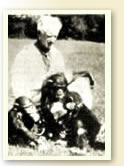|

Robert M. Yerkes (1876-1956) was about 24 years old when he first started planning for his study of primates. His first published plans for such an undertaking appeared in the February 18, 1916 issue of Science. It wasn’t until he left Harvard University for Yale that his plans started to become a reality.
In 1925, Yerkes purchased four chimpanzees--Bill, Dwina, Pan, and Wendy--and established the Primate Laboratory of the Yale Institute of Psychology at 135 Prospect Street in the old Manson Barn in New Haven, CT. Here the early work on chimpanzee behavior, intelligence, and personality began. (In 1923, Yerkes purchased a bonobo (Prince Chim) and a chimpanzee (Panzee) whom he had hoped to study into maturity; however, they both died within a year.)
In June, 1930, with financial support from the Rockefeller Foundation, Yale opened the Anthropoid Experimental Station in Orange Park, Florida under the directorship of Yerkes. Twenty chimpanzees joined the colony, which was split between the Northern (New Haven) and Southern (Orange Park) divisions. (16 were brought from Africa by Henry Nissen, 3 were purchased from other sources in the US, and the first “home grown” chimpanzee, Alpha, was born into the colony.) The following year, what was now called the Laboratories of Comparative Psychobiology received 10 more chimpanzees from the Abreu Estate in Cuba and the comprehensive study of chimpanzees was underway.
By 1935, the now called Yale Laboratories of Primate Biology (YLPB) was successfully breeding chimpanzees and Yerkes was imagining creating a "subject incomparably more serviceable for research than any available natural type.” He wrote that:
The ideal experimental chimpanzee should then be small, with tough skin, thick heavy coat, long and delicate hand and foot; vigorous, robust, assimilative efficient, disease-resistant, preferably with specific immunities; short gestation period, rapid maturation and development, high fertility, twin-production; behaviorally highly adaptive, active, original, non-destructive, cooperative; naturally tame and readily gentled, non-pugnacious, affectively stable and with high emotional threshold, unselfish or altruistic, frank, dependable, easy to handle, good-natured, even-tempered; and, finally – a far cry – as nearly as practicable homozygous.
Although he was never successful in creating the ideal chimpanzee “servant of science” the colony continued to grow and Yerkes remained as the director of YLPB until 1941. In 1942, Karl Spencer Lashley took over as the director of what was now called the “Yerkes Laboratory of Primate Biology”. The YLPB was now under the auspices of both Yale and Harvard, the New Haven laboratories were no longer a part of the YLPB, and the chimps from the Northern Division were sent back to Orange Park. The Lashley years were different for the chimpanzees in many respects from Yerkes’ tenure. Details about individual chimpanzees were scarcely reported and the nature of the research being performed in Orange Park became more invasive. After Lashley fell ill in 1954, Henry Nissen, who had been involved with YLPB since its inception took over and officially became director in 1955. Details about individual chimpanzees were reported again, but not with the level of specificity that existed in the early years, under Yerkes' directorship. Nissen had for over a decade run the Infant Study Program that involved separating infants from their mothers to raise them under a variety of conditions in the nursery. In 1957, Nissen went to remove an infant from Helene when she was not sufficiently tranquilized. Helene grabbed Nissen, causing him to fall and damage his back. He never adequately recovered, his physical and mental health deteriorated, and in 1958 he committed suicide.
In 1956, plans were underway to transfer YLPB to Emory University and the period from Nissen’s death to the eventual move in 1965 to Atlanta saw three additional directors and an increase in the number of animals, not just chimpanzees, being housed at Orange Park. In addition to more births, chimpanzees and gorillas were being brought from Africa, orangutans from Indonesia were also brought to Florida, as well as a variety of different kinds of monkeys. A 1962 inventory listed 79 chimpanzees, 1 gorilla, 4 orangutans 11 gibbons, 4 green monkeys, 3 pigtails, 12 cebus, 25 rhesus monkeys, 7 tree shews, 12 squirrel monkeys and 1 cynomolgus monkey.
In June 1961, the Yerkes Laboratory for Primate Biology became one of 7 federally funded Regional Primate Research Centers. On July 15-17, 1965, the colony was moved from Orange Park to Atlanta in “a ventilated van with two drivers…rented from Allied Van Lines…the nursery animals were moved in our own vehicles the following week.…Member of the staff of the Center drove with every load and were equipped with tranquilizer guns and a pistol in case of a breakout or a road accident.” According to then Director Geoffrey Bourne, “The whole move was accomplished without an incident of any kind. The animals settled in at once in their new quarters, and no animal suffered injury or illness as a result of the move.” Many of the animal care staff and the researchers moved with the animals and took up residence in Atlanta.
As of April 2005, there were 109 chimpanzees held in the laboratories at Yerkes National Primate Research Center in Atlanta. Many of the chimps at Yerkes today are descendents from the First 100. Other descendents are in other research facilities in the US that still use chimpanzees. Fortunately, some of the descendents made it to sanctuary. For information on chimpanzees in sanctuaries in North America, go to:
Chimp Haven, Save the Chimps, Center for Great Apes, Fauna Foundation, and Chimpanzee Sanctuary Northwest.
|